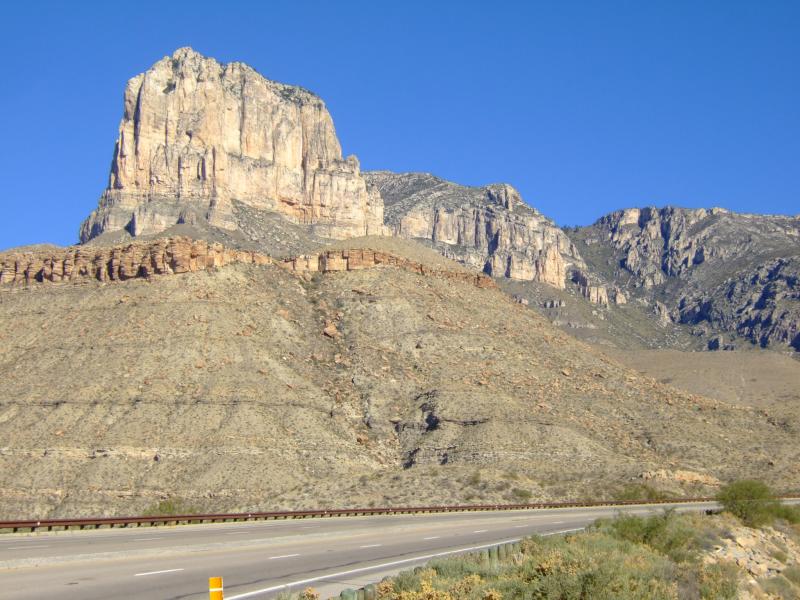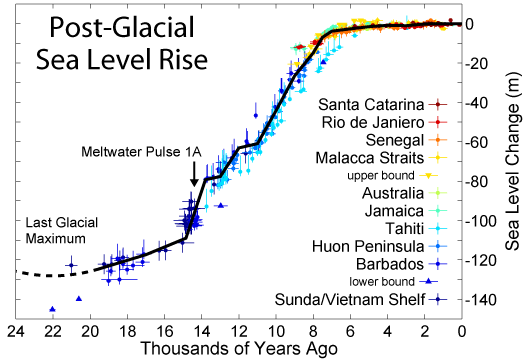Coral reefs are living things. They grow.
Coral atolls always stay right at sea level. As sea level rises, the reefs grow – like these ancient reefs in the West Texas desert which are many thousands of feet thick did. As long as the people of the Maldives don’t damage the reefs they live on, the islands will grow upwards as sea level rises.
Sea level has risen 400 feet in the last 20,000 years. It has nothing to do with capitalism or sport utility vehicles.
Ten thousand of these anti-science morons known as “progressives” are currently gathered in Paris.




The bedwetters have a scam for everything, so oceans of boiling acid are their answer to living reefs. I suspect there isn’t enough CO2 in the entire atmosphere to change the ph of the oceans enough to matter, but progstains don’t do math…. or reality.
But they sure do know how the lie and spread propaganda.
First they have to dissolve the entire ocean basin….
OH MY GOODNESS, Ocean Acidification will dissolve a whole right through the Earth!!!
http://cdn.trendhunterstatic.com/thumbs/earth-cake.jpeg
whole = hole, I really am losing the spelling battle…
LOL…coffee didn’t help me one bit
Tea in my case. Though probably more of a lack of oxygen. I shouldn’t muck out two stalls in a row with an asthma problem.
Went for a body-surf in a 5ft swell the other day..
Tell you what……. there is one heck of a lot less oxygen out the back of those waves than there was 10-20 years ago !!
Andy, Ain’t growing old a bitch?
Youth is very much wasted on the young. What is really horrifying is I can still out walk and out work most American teens.
if we turn out the lights and turn in our cars and share our wealth, Big Brother will promise to make better weather for our grandchildren. Martin says we can’t disprove that, so it must be so!
Male is doomed because they are not allowing the islands to grow. They have built roads, seawalls, settlements and other fixed infrastructure atop coral that is subsiding. Preindustrial settlements with their temporary structures allowed the islands to accumulate coral debris and thus stay above water as the underlying volcanic rock sank. By building permanent structures on temporary land, they’ve brought it upon themselves.
Very true.
WUWT had several articles on the care and feeding of coral islands:
2010 Floating Islands
2012 Kiribati on the move – but not sinking
2013 Why The Parrotfish Should Be The National Bird
2014 The Reef Abides … Or Not
2015 Told ya so: new paper proves that coral atolls keep up with sea level rise
They are more ‘delicate’ than sand bar islands, which are another favorite of the Alarmists.
Thank you for allowing me to post evidence the UN’s Climate Conference in Paris is just the conclusion to:
1. The 70-year plan by the USSR and NAS to rule the globe, and
2. The Catholic Church’s ~500 year plan to hide from the public
the actual “Creator & Sustainer of every atom, life and planet in the solar system“:
https://dl.dropboxusercontent.com/u/10640850/USSR_Abbreviated-Expanded.pdf
Feel free to ask any scientist to comment, criticize, or correct the above evidence of scientific fraud.
https://www.facebook.com/313827422002524/photos/a.392679234117342.110757.313827422002524/1023293797722546/?type=3&theater
http://www.webweaver.nu/clipart/img/people/men/rotlmao.gif
Hubby cam over to see what I was laughing about and loved it too.
OMG!
A couple of these just make me want to scream:
Sustainability WTF is that? How do you measure it? What are its units? And cotton-heads talk about it like it’s a real something…what is it?
Climate Protection / Climate Catastrophe Really? I mean does anyone what to sign up to protect the climate? What does that even mean? And Climate Catastrophe? Where? What? Huh???
All these terms and words are just that; words. Word-play put into the service of the dark art of sophistry.
“Sustainability” started out as a real word for soil re: agriculture. Can you keep adding chemical fertilizers and pesticides to the soil and sustain a crop forever, or do you ruin the soil? How do you keep the soil sustainable for crops?
Then the pinko’s grabbed the word and used it for their acid-head climo trance dance.
And real farmers went ballistic about having their perfectly good definition twisted all out of recognition. This is especially true of livestock farmers who are a target. Rotation of crop land to grass pasture is a good way to rebuild much needed organic matter in soil.
Actually the whole 25X25 resolution is about as UNsustainable as you can get!
“H.Con.Res.: Expressing the support of Congress for the “25 x ‘25” initiative, which envisions that farm, forestry, and ranch lands in the United States will provide by 2025 at least 25 percent of the energy consumed in the United States, and, in furtherance of the “25 x ‘25” initiative, promoting the increased production of renewable energy by the forestry and agricultural communities.”
Think about it. You grow corn and instead of feeding people or livestock it is fermented to make bio-fuel. That is not too bad because the leavings, distillers grains, is then made in to livestock feed and put back onto the soil. (If the EPA doesn’t ban cattle or manure spreading.)
However now, instead of the rest of the plant being tilled back into the soil the whole corn plant is set to be taken to produce energy along with grass and wood chips. The organic matter may not make its way back to the soil, not even as poop if it is burn to produce energy. You can be damn sure the EPA, FDA, and USDA will ban the spreading of the ash on fields to return the nutrients to the soil. If burned by the farmer in a wood stove (banned by EPA) the wood ash is often spread on the garden/fields. And boy will that make a garden GROW! (BTDT)
>>>>>>>>>>>>>>>
Here are the various dots:
The 2009 Food Safety Modernization Act as it goes into effect will regulate the manufacturers of ethanol IF the byproduct, distillers grains, goes into animal feed. This will cause a major increase in the price of livestock feed and/or cause the manufacturers of ethanol and distillers grains to say the hell with it and send the distillers grain off to be pelleted for the energy companies to burn instead. It will be a lot less headache for the livestock grain pelleters too if they switch the production plant from livestock feed to energy company pellets. Cost of material (mineral and Vit. additives) and regulation will drop through the floor. So what’s not to like?
New Headaches For Distillers Grains Producers
I already went over The Dietary Guidelines Advisory Committee (DGAC) came up with the recommendation that America Should Adopt a ‘Plant-Based’ Diet. this spring. A great way to kill the meat industry is to restrict grain or make it very, very high priced. We see that plan in action above.
Grass (hay) is targeted too Burning Grass Pellets as a Biofuel is Economical, Energy-Efficient, Environmentally Friendly and Sustainable
Their “Biomass Energy Comparison
Various materials tested by: Agricultural Utilization Research Institute, Waseca, Minnesota” Shows among a great many others:
Hardwood Pellets: 7955 – 8573 BTU/lb
Alfalfa (leaf and stem) (Best livestock hay) 6934 – 7729 BTU/lb
Dried Distillers Grain 8459 – 9848 BTU/lb
Dried Distillers Grain is at the top of the pack for BTU/lb! It also gives Ash & Sulphur and there Dried Distillers Grain is in the middle of the pack.
The scientists are also into the act of converting our food crops into specialized fuel crops.
Corn Primed for Making Biofuel
Corn is very hard on the soil. It is a heavy feeder, it has a skimpy shallow root system and at least for food/livestock crops, is planted far apart exposing the soil to erosion.
This is the best I can find on the negative aspects of corn mono-culture. Note they are only looking at carbon (organic matter) in the soil and adjacent the forest is the control. If it is like my farm, the soil from the fields washes into the forest during rain storms so the topography/runoff could be an important factor. Also this is a Canadian journal and they may not have the really hard rains I see here in the mid south USA.
Changes in soil carbon under long-term maize in monoculture and legume-based rotation
Gail, [youtube https://www.youtube.com/watch?v=P2n83VMn0TU&w=640&h=360%5D
Climate protection ?
You’ll never get wet wearing one of these. !!
http://i.kinja-img.com/gawker-media/image/upload/s–J0hPlfj2–/18jeehwhikejnjpg.jpg
SuperMandia has a change of uniform.
http://www.magicandfancydress.com/ekmps/shops/pauldaniels/images/Condom-Man-Costume-One-Size-%5B1%5D-269925-p.jpg